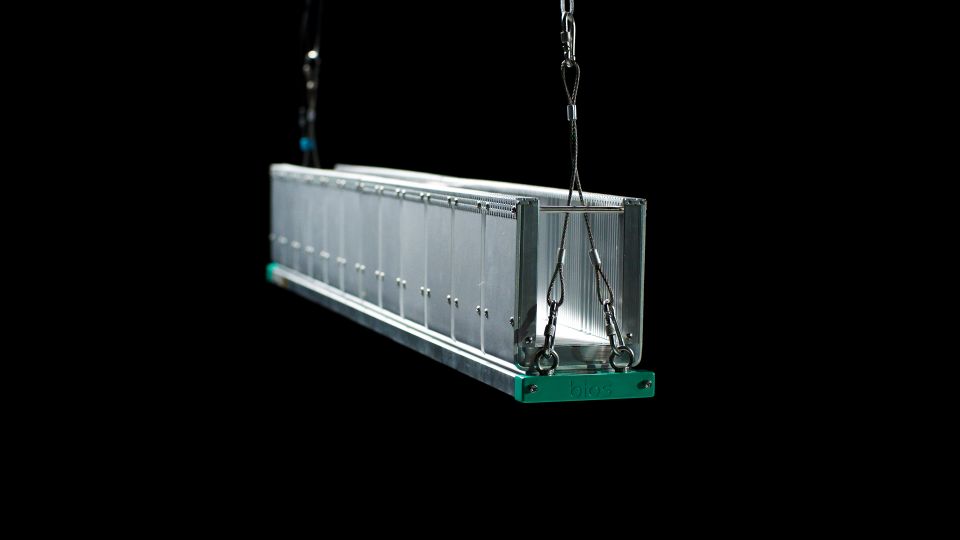Growers Increasingly Turn to LED Lighting

It’s important that growers understand technical specifications of a product, and they must know that not all LEDs are alike. One specification that is critical, especially with a new build, is a product’s inrush current. Photo: Signify/Philips Horticulture LED Solutions
LED technology in greenhouse lighting has been around for a while, but the shift within the industry remains gradual as growers weigh the potential benefits against the upfront costs and other factors.
Keep reading to learn more about where the market is headed from three leading companies in greenhouse lighting systems: John Burns, Key Account Manager with Signify/Philips Horticulture LED Solutions; Patrick Kamphaus, Director of Business Development at BIOS Lighting; and Todd Phillips, Owner/President of P.L. Light Systems.
Most Common Concerns and Challenges
Burns: “Inconsistent and insufficient lighting in a greenhouse environment is one of the most common challenges. Natural light levels can be unpredictable, and we’ve also heard of growers who have not installed enough supplemental lighting into their greenhouse operation to effectively manage production.”
Phillips: “Against the backdrop of a looming economic recession, inflation, and rising energy costs, current activity seems skewed toward retrofit projects vs. large new capital projects (many of which have been put on hold). Growers are being very cautious with their finances and want to make sure they are making smart, responsible decisions when it comes to significant capital expenditures, including lighting. They want to secure the best possible price upfront, but also want to realize reduced energy and maintenance costs moving forward.”
Factors to Consider When Upgrading
Phillips: “Growers should consider the quality of light their current system is delivering, along with their annual operating costs (including energy consumption and maintenance) and compare that to the CapEx, energy and maintenance savings, and potential yield increase of a new lighting system. They should consider all the potential types of lighting retrofits and decide which solution will best meet their particular needs and goals.
In terms of timing, there are many factors that would influence each individual grower’s decision. For example, if they are eligible for a good lighting rebate program, they may want to proceed with an upgrade sooner than later, since electricity providers change these programs regularly and a delay might mean the grower misses the opportunity. Likewise, for growers still using older magnetic lighting technologies, finding replacement lamps and other parts like capacitors and ignitors, is becoming very difficult, if not impossible.”

LED lights are designed to last 10 years or more, which means 10 years of not having to get up on a ladder and change bulbs. Photo: BIOS Lighting
Kamphaus: “Growers are often hesitant to add any additional costs. The problem is that they are at the mercy of Mother Nature. A couple weeks of overcast skies in the spring can delay finish times. If you’re working with big retailers and you have Mother’s Day dates to hit for deliveries, you need to make sure you have those crops available when they’re needed.
Rising energy costs are certainly leading growers to at least consider making the switch. They know it’s a new technology, and they know it doesn’t necessarily make sense to keep spending money on bulbs and maintenance when they could put that money into a better, newer, more durable technology.”
Benefits of a Modern LED Lighting System
Kamphaus: “There’s reduced maintenance costs. LED lights are designed to last 10 years or more, which means 10 years of not having to get up on a ladder and change bulbs. Older lights also have reflectors that need cleaning or replacement every couple years to maintain the same performance. LEDs are just more durable and longer lasting, so the return on the investment is continual.”
Burns: “Newer technologies can deliver light spectrums optimized for both yield and electrical efficiency. Spectral tuning is one of the most exciting aspects of LED lighting. However, since different plants and cultivars can have different growth responses to different wavelengths under otherwise identical environmental conditions, commercial growers might want to use a fixed spectrum optimized for use across multiple crops or cultivars and full growth cycles, rather than offering highly customized light recipes that only work for very specific applications. One of the key benefits of LED lighting is the flexibility it offers in terms of lighting control and dimming. Growers would be advised to select luminaires that are designed with a standard dimming protocol like 0-10V, so their lights are compatible with any environmental control system they choose.”
Many growers are taking advantage of the benefits of LED lighting. Despite challenges such as inflation and rising energy costs, growers see the long-term benefits of upgrading their lighting systems. The return on investment makes the switch worthwhile.









